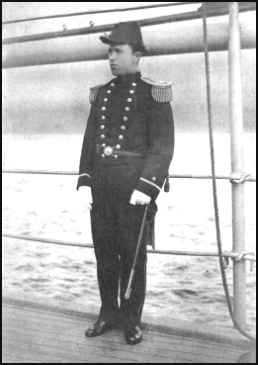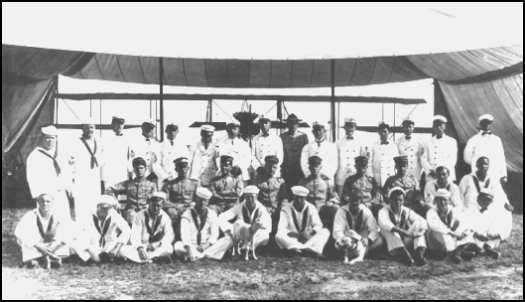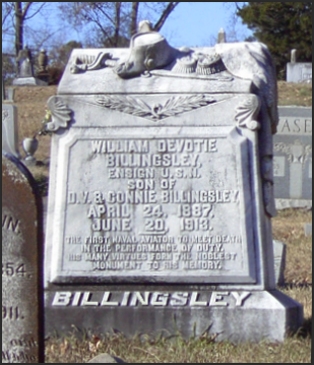

1887-1913 AKA DeVotie Billingsley |
 |
 |
A midshipman at Annapolis. Photo & legend courtesy of Paul Shaw, 8-30-06 |
" I don't know which ship he was on when it was taken. The date of the photo is between 1911 and 1913." Photo & legend courtesy of Paul Shaw, 8-30-06 |
 |
|
Lieutenant(Junior Grade) Patrick N.L. Bellinger, USN; First Lieutenant Bernard L. Smith, USMC; First Lieutenant Alfred A. Cunningham, USMC; Lieutenant John H. Towers, USN; Ensign Victor D. Herbster, USN; Ensign William D. Billingsley, USN; Ensign Godfrey deC. Chevalier, USN. Note goat and dog mascots and canvas hangar with a Curtiss "A" type airplane inside. Collection of CommanderTheodore G. Ellyson. U.S. Naval Historical Center Photograph. |
|
Ensign, United States Navy Aviator from Winona, Mississippi April 24, 1887 - June 20, 1913 My grandmother, Alma Billingsley Shaw, wife of Oliver A. Shaw of Winona, lived in Winona for the first part of her life. She had several brothers and sisters, one of whom was Devotie. Here is what I remember from family stories, and from Navy archives. Shortly after graduating from the Naval Academy, Devotie entered the new Navy flying program and reported to the Aviation Camp in Annapolis, Md. to train on the Navy-Wright B-2 aircraft on Dec. 2, 1912. He was designated "Aviator No. 9." On January 6, 1913, the aviation group went to Guantanamo Bay, Cuba to train with fleet ships in scouting missions, searching for submarines, bombing runs, aerial photography and to accustom fleet personnel with working with aircraft. It was the first aviation base for Naval operations with the fleet. Earlier experiments with modifying aircraft into "hydroaeroplanes" had been going on since early 1911; that project was now extended to the B-2 biplane. In early spring of 1913, the aviation group returned to Annapolis. On June 20, 1913, Devotie was piloting a Wright B-2 biplane with the pusher prop, rigged with pontoons which would allow water landings. Lt. John Towers, who had already proven himself an innovative pioneer in early Naval aviation, was Billingsley's passenger. The two sat at the leading edge of the wing; at that time, there were no seatbelts in use. It would prove ironic that the B-2 had been designed without the front canard, but was built with a rear elevator, unlike earlier Wright biplanes. The design was intended to give the aircraft "better longitudinal stability." It was in a trial run, bracketed by an aircraft in front, and one to the rear for observation purposes. I don't know if either of the other aircraft were amphibs, or not. The following paragraph is taken from the Army Navy Journal dated June 28, 1913. It agrees with the family account: "Ensign Billingsley, in a Wright biplane, B-2, that had been converted into a hydroplane by the addition of pontoons, with Lieutenant Towers as a passenger, started from the aviation camp in the morning at about ten for Claiborne, on the eastern side of the bay, eighteen miles from Annapolis. A Curtiss machine, with Ensign G. DeC. Chevalier and Lieutenant I. F. Dortch, U.S.N., also took the trip. They were followed at a distance of several miles by a launch containing Chief Elec. B. L. Bronson, a mechanician at the camp; F. Killian, a seaman, and M. J. Twigg, a student of St. John's College and friend of Ensign Billingsley." According to Lt. Towers and the observers on the other airplanes, the Billingsley craft hit an air pocket and dropped abruptly, lurching forward and down, throwing Billingsley from the wing and through the forward supports, his body damaging the rigging to the point that the upper wing folded down, dooming the aircraft. Lt. Towers, also thrown from the airplane, luckily caught a strut or cable with his arm, and clung to the now-collapsed airplane as it plummeted toward the water, 1,600 feet below. Devotie's father, William Devotie Billingsley, would for years sit in his Mississippi home and relate the details of his son's demise, telling how Devotie's body spiraled around and around as he fell toward the river. He would indicate the spiraling death fall with his hand before holding his face in his hands and mourning his great loss. Lt. Towers rode the damaged plane almost to the water. The plane, at first taking a steep nose-dive, swooped to a level attitude a couple of times as it descended, then resumed its precipitous decline. Just before it impacted the river, the wreckage leveled out enough for Towers to push himself clear, and fall to the water. The story I heard was that Lt. Towers impacted the water on his side, and was rescued by onlookers. Confident that he may well die, he insisted on giving his account of the accident before being taken for medical attention. The early aviators were brave and daring men, and no doubt knew there were high risks involved. The Navy, in appreciation of Devotie Billingsley's sacrifice, named a destroyer after him. In March, 1920, the USS Billingsley, DD-293, was commissioned. Paul H. Shaw Harriman, Tenn. |
|
via email from Paul Shaw, 8-22-08 Thomas Martin Billingsley was a brother of the senior William Devotie Billingsley.In one of those odd genealogical twists we see so often, it turns out that Thomas Martin Billingsley married Anna Shaw. Anna Shaw was the half sister of Oliver A. Shaw (my grandfather). Oliver A. Shaw married Alma Billingsley who was a daughter of the elder William Devotie Billingsley. If you chart this out, it turns out that Alma Billingsley's sister-in-law (Anna) was also her aunt (by marriage to Alma's uncle Mart). Whew! Then there are the two sisters of Alma and Devotie who married twin brothers named Stone. That family tree is a strange thing to behold. Paul |
|
"June 20, 1913: Ensign William D. Billingsley becomes the first fatality of naval aviation. Piloting the B-2 at 1,600 feet over the water near Annapolis, Md., he was thrown from the plane and fell to his death. Lt. John H. Towers, riding as a passenger, was also unseated but clung to the plane and fell with it into the water, receiving serious injuries." You can access the page by clicking on the title above. |
|
|
|
|
|
Updated: Oct 24, 2011 12:56 PM PDT By Bert Case - bio | email "A historical marker was dedicated this morning in Winona, to Ensign William Devotie Billingsley, the first Naval aviator to die in the line of duty." You can read the rest of the story on the WLBT.com homepage by clicking on the link. Also, you can enjoy a very nice video clip of the event by clicking on the screen at the right of the page. |
|
Daily Journal and Tribune, Knoxville, Tennessee: June 28, 1913, Transcribed by Bob Davis - 7-12-04 |
 |
IN THE PERFORMANCE OF DUTY. HIS MANY VIRTUES FORM THE NOBLEST MONUMENT TO HIS MEMORY. |
|
If you have any more information on this pioneer aviator, please contact me. E-mail to Ralph Cooper Back 

|